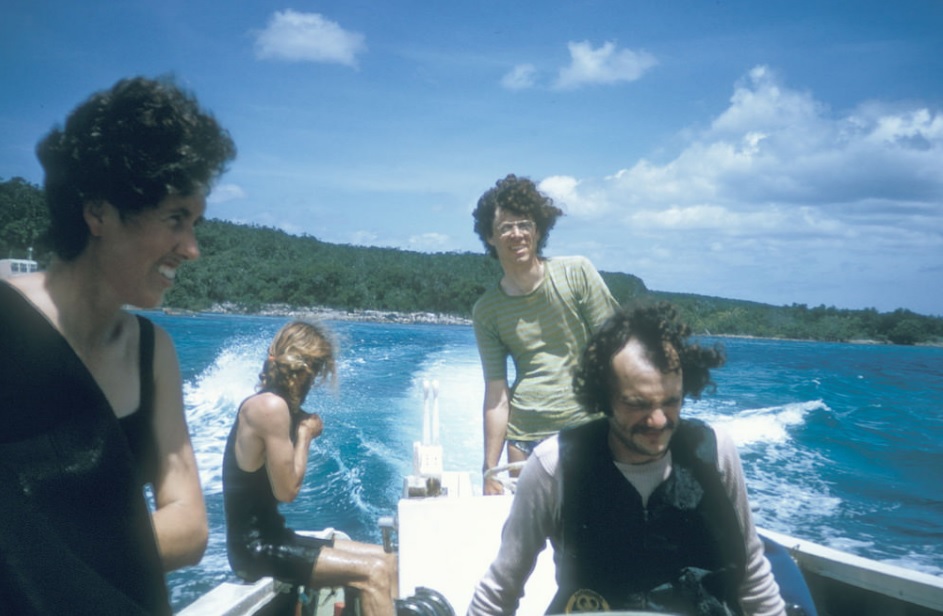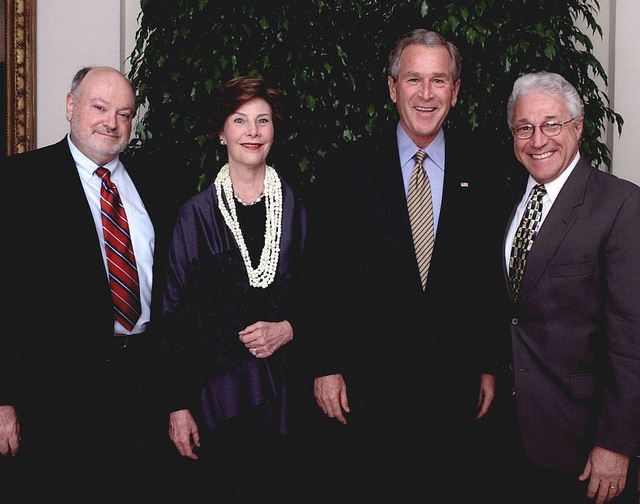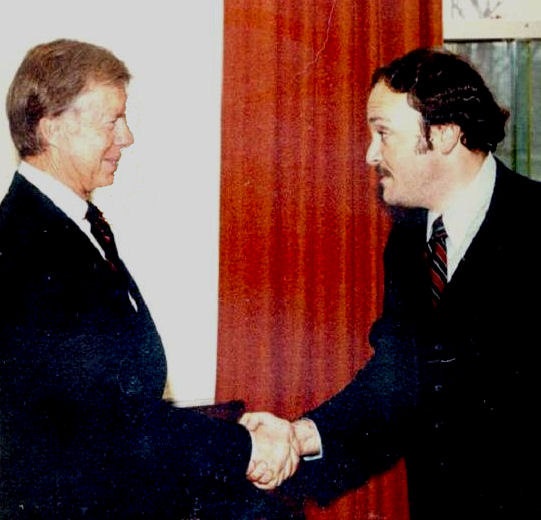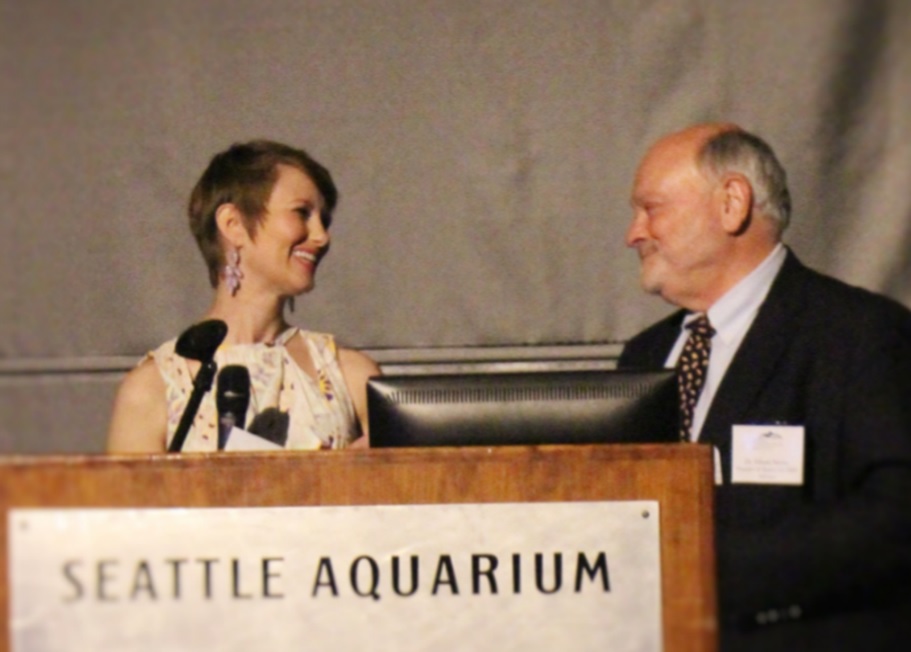Dr. Elliott Norse, a leading name in the field of marine conservation science, and a founding member of the Society for Conservation Biology, is retiring after more than four decades dedicated to conserving marine biodiversity. Norse published the Global Marine Biological Diversity in 1993, the world’s most-cited book on marine conservation. In 1996, Norse founded the Marine Conservation Institute and has spent the last 20 years working to protect marine ecosystems. One of the Marine Conservation Institute's goals is to bridge the gap between scientists and policy makers. In 2000, the organization urged President Bill Clinton to create a national system of marine protected areas, and in 2006 and 2009, persuaded President George W. Bush to establish three marine protected areas in the tropical Pacific Ocean.
In early May, a retirement party was held to honor Norse for his career achievements and dedication to conserving marine biodiversity. SCB talked with Norse about his achievements and his thoughts on the past, present and future of marine conservation.
 |
|
Norse in Jamaica Bay. |
How do you view the state of marine conservation today compared to 1996 when you founded the Marine Conservation Institute?
The science of marine conservation is much stronger than when we started Marine Conservation Biology Institute (our original name) to advance the science of marine conservation biology and secure protection for ocean ecosystems. Some measures of this are objective and quantifiable. Irish and Norse (1996) “Scant emphasis on marine biodiversity” Conservation Biology 10: 680-681 found that only 5 percent of the papers in our journal’s first 9 volumes were marine (vs 67 percent terrestrial). The marine percentage in Conservation Biology is probably higher now, and there seem to be far more papers per year on marine conservation in other scientific journals as well. It would be useful for a young scholar to quantify these changes. We can celebrate that thousands of scientists are now working on marine conservation, a profound change from 1996. More important for conservation, however, are in-sea measures such as growth of strong marine protected areas. But despite encouraging signs in our field and in some ocean places, the risk of biodiversity collapse is greater than ever. Marine conservation biologists (in the broad sense, as so many aren’t biologists now) are the keystone truth-tellers for maintaining marine life and processes.
From coral bleaching to overfishing, ocean ecosystems face grave threats. What opportunities do you see going forward to mitigate these threats and advance marine conservation?
Twenty-three years ago, Global Marine Biological Diversity (Norse 1993), explained that the five proximate causes of biodiversity loss -- overexploitation, habitat destruction, pollution, nonindigenous species and climate change -- were driven by five underlying forces: increasing human population and per capita consumption, insufficient knowledge, insufficient urgency and inadequate institutions. Most of these threats have increased to the point where time is short to address them, but it’s not too late. Now there are workable solutions such as the Global Ocean Refuge System (GLORES) to save biodiversity in all regions and ecosystems in the world’s largest biotic realm. Now scientists, policy experts, nongovernmental organizations, governments and intergovernmental organizations need to find effective ways to coalesce and act together to avert this existential threat to the seas and us. We do not have years or decades. The time is now.
 |
|
Norse with President George W. Bush and First Lady Laura Bush. |
You played a role in President Bush’s decision to create the Papahānaumokuākea Marine National Monument. How did you get involved in the process and what were the greatest barriers/challenges to creating such a large conservation area? What’s the biggest challenge to protecting such a large space?
No conservation success results from one action, person or organization; there are always multiple steps, interests and players. In 2004, the Environmental Defense Fund asked MCBI to help secure increased protection for waters around the Northwest Hawaiian Islands. By good fortune, my friend, former Congressman Jim Greenwood, was also a friend of President George W. Bush. In 2005, he and I brought a small group of marine scientists to meet with Jim Connaughton, the White House’s chief advisor on environment. Just before he adjourned the meeting, I proposed that President Bush could win widespread, lasting acclaim for declaring these waters as the world’s largest highly protected area. That changed the game. MCBI then worked to provide a strong scientific case for protecting these waters. In 2006, minutes before a group of us had dinner at the White House, President Bush indicated to us his intention, and weeks later (with strong support from Mrs. Bush, I’ve heard), he made it happen. Moreover, this wasn’t a one-off victory; Papahānaumokuākea set off the accelerating worldwide movement to give strong, enduring protection to very large ocean areas. Now there’s growing support in Hawaii and elsewhere for Hawaii-born President Barack Obama to expand Papahānaumokuākea, signifying America’s strong commitment to safeguard our oceans as climate changes. Presidents Obama, Bush, their families and many other people will celebrate their historic achievements decades from now. But the biggest challenge continues to be that too few political leaders consider saving marine life to be their high priority.
 |
|
Norse with President Jimmy Carter. |
You’ve advised several administrations in your career. What do you consider your most impactful or rewarding experience in the policy arena?
Having been several times in the right place at the right time to advance conservation, I see the idea of biodiversity as the most impactful thing I did. Days after I became the White House’s Staff Ecologist in President Jimmy Carter’s Administration, my boss Malcolm Baldwin, tasked me with examining the status of life on Earth. He was thinking big, and he wanted Wildlife Biologist Roger McManus to join me in writing the “Biological Diversity” chapter of Environmental Quality 1980. We defined what we meant by biological diversity (not quite correctly until it was fixed in Conserving Biological Diversity in our National Forests Norse et al 1986) and warned of its rapid loss. The big idea: conservation isn’t just about things people use as resources or endangered species; first and foremost it’s about maintaining the diversity of genes, species and ecosystems in our fragmenting, warming world. Making biodiversity the overarching goal has changed conservation worldwide. Now humans’ existential challenge is whether we will create and sustain institutions—e.g. GLORES—that are smart, resilient and durable enough to save the diversity of life in ways that are economically sound, as fair as we can make them, and ready soon enough.
What advice do you have for young marine scientists who want to make an impact in preserving life in the world’s oceans?
The world didn’t listen enough to founding marine conservation biologists. Your generation must change that. While assembling the Ransom A. Myers Memorial Lecture to conclude the 3rd International Marine Conservation Congress (IMCC), I realized that very few scientists were in marine conservation in the ‘70s and we didn’t have a place to talk. Nearly all of us were white males from a few countries who had trained as some kind of marine biologist. Now much larger numbers of marine conservation biologists come from countries around the world, are younger, majority-female, much more interdisciplinary and people-savvy than my generation. Your generation brings insights from anthropology, economics, genome analysis, biologging, biostatistics, climatology, predictive habitat modeling and more. With Australia (for many years the world leader in marine conservation science) firing its climate scientists while the Great Barrier Reef suffers appalling coral bleaching, we will succeed only if you continue hoping, learning all you can and pushing to change the course of events. Emulate coral reefs and mangrove forests by creating keystone mutualisms with your fellow scientists because a diverse group of experts speaking with one clear, strong voice is far more powerful than a cacophony of competing voices. That’s my advice.
 |
|
Norse with SCB Marine President-elect Sam Oester. |
You’re a founding member of SCB. What role can professional societies like SCB play today in protecting the world’s biodiversity?
When Michael Soulé gathered his friends and admirers in Ann Arbor in 1985, we were already planning to start a new scientific society focusing on biodiversity conservation. SCB gave us an ongoing forum to strengthen our scientific identities by talking and learning from our colleagues. At first there was more emphasis on thinking than on doing conservation, and marine life was woefully underappreciated. But thanks to some very good people, that has changed for the better. Now I’d love to see SCB be more proactive in helping decisionmakers understand key aspects of marine conservation. And I’d love to see SCB’s Marine Section assume a major role in advancing the Global Ocean Refuge System. After all, GLORES’s conceivers are SCB members! GLORES needs sustained, active participation from the best natural and social conservation scientists to succeed.
 |
What’s next for you after your retirement?
I still owe thanks to all the kind friends who’ve sent congratulations. But now the meeting invitations and travels are fewer, which I love, and I’m not planning any more books. Retirement has freed me to watch birds’ behaviors in my backyard, to tend my flowers, fruit trees and salad greens, to read and think about the world and to celebrate life with Founding MCBI board member (and my wife) Irene Norse, whose loving support has for so long made all the difference. Although our planet is increasingly imperiled, I take real comfort in knowing that there are now so many more bright young scientists devoted to maintaining the diversity and functioning of the only biosphere we’ve got.
Do you have anything else to add?
Think big, and…Please accept my appreciation for the good things you’re going to do.